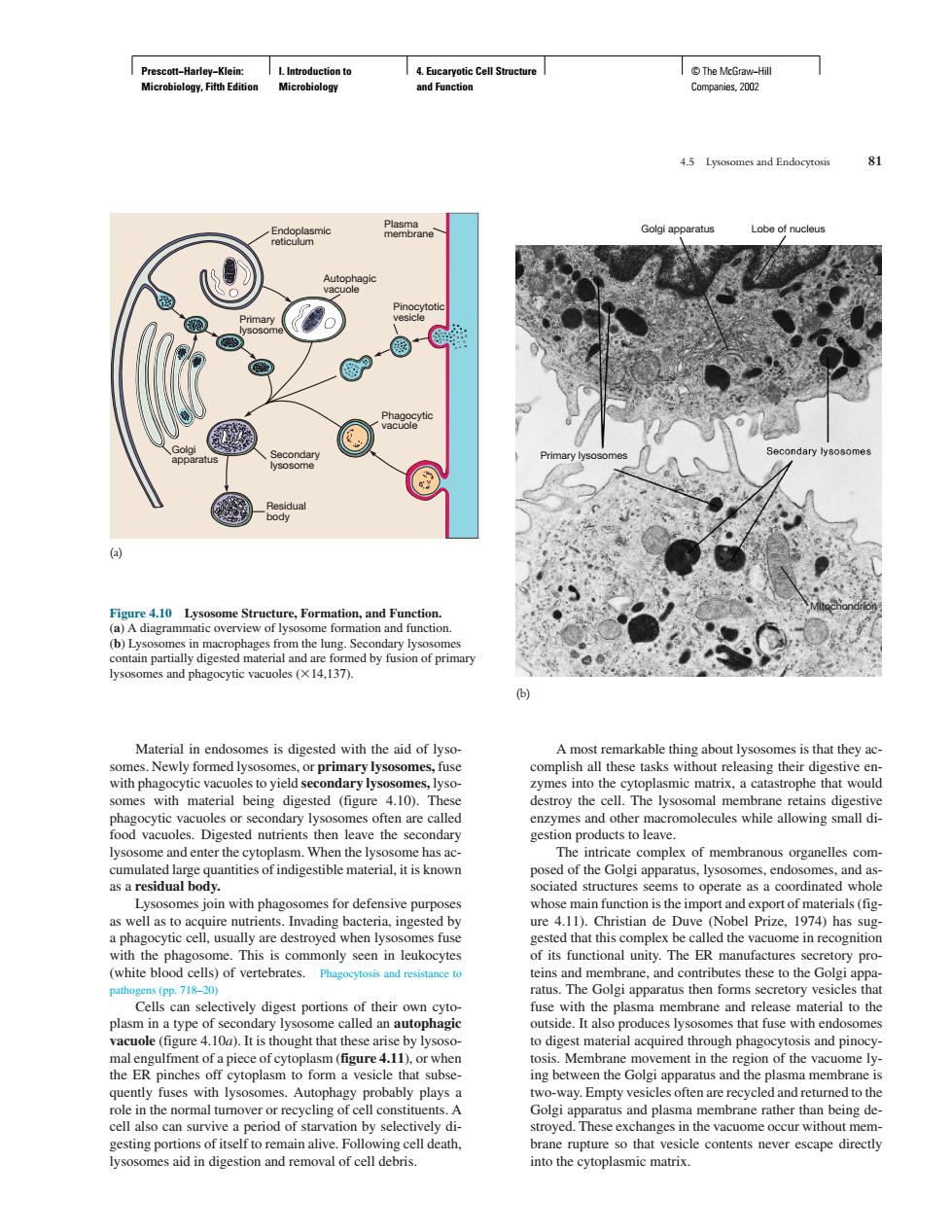正在加载图片...

tic ov nd functio diges ed by ×141371 sec 410 s,lysc catastrophe th would r secondary lys s and other macromolecules while allowing small di. n products to leave com who materials( Invading ba ure 4.11).Chr istian e()has of its functional uniry.The ER manufactures secretor (white blood cells)of vertebrates. fuse with the plasma mem rane and de.It also 0a)It is cytoplasm(figure 4.11.or Membrane me ovement in the me ly a ves ing betwe led and Golgi atus and plasma membrane rather than being de ysosomes aid in digestion and removal of cell debris. into the cytoplasmic matrix. Prescott−Harley−Klein: Microbiology, Fifth Edition I. Introduction to Microbiology 4. Eucaryotic Cell Structure and Function © The McGraw−Hill Companies, 2002 4.5 Lysosomes and Endocytosis 81 Figure 4.10 Lysosome Structure, Formation, and Function. (a) A diagrammatic overview of lysosome formation and function. (b) Lysosomes in macrophages from the lung. Secondary lysosomes contain partially digested material and are formed by fusion of primary lysosomes and phagocytic vacuoles (14,137). Endoplasmic reticulum Primary lysosome Secondary lysosome Residual body Golgi apparatus Phagocytic vacuole Pinocytotic vesicle Autophagic vacuole Plasma membrane Mitochondrion Golgi apparatus Lobe of nucleus Primary lysosomes (a) (b) Material in endosomes is digested with the aid of lysosomes. Newly formed lysosomes, or primary lysosomes, fuse with phagocytic vacuoles to yield secondary lysosomes, lysosomes with material being digested (figure 4.10). These phagocytic vacuoles or secondary lysosomes often are called food vacuoles. Digested nutrients then leave the secondary lysosome and enter the cytoplasm. When the lysosome has accumulated large quantities of indigestible material, it is known as a residual body. Lysosomes join with phagosomes for defensive purposes as well as to acquire nutrients. Invading bacteria, ingested by a phagocytic cell, usually are destroyed when lysosomes fuse with the phagosome. This is commonly seen in leukocytes (white blood cells) of vertebrates. Phagocytosis and resistance to pathogens (pp. 718–20) Cells can selectively digest portions of their own cytoplasm in a type of secondary lysosome called an autophagic vacuole (figure 4.10a). It is thought that these arise by lysosomal engulfment of a piece of cytoplasm (figure 4.11), or when the ER pinches off cytoplasm to form a vesicle that subsequently fuses with lysosomes. Autophagy probably plays a role in the normal turnover or recycling of cell constituents. A cell also can survive a period of starvation by selectively digesting portions of itself to remain alive. Following cell death, lysosomes aid in digestion and removal of cell debris. A most remarkable thing about lysosomes is that they accomplish all these tasks without releasing their digestive enzymes into the cytoplasmic matrix, a catastrophe that would destroy the cell. The lysosomal membrane retains digestive enzymes and other macromolecules while allowing small digestion products to leave. The intricate complex of membranous organelles composed of the Golgi apparatus, lysosomes, endosomes, and associated structures seems to operate as a coordinated whole whose main function is the import and export of materials (figure 4.11). Christian de Duve (Nobel Prize, 1974) has suggested that this complex be called the vacuome in recognition of its functional unity. The ER manufactures secretory proteins and membrane, and contributes these to the Golgi apparatus. The Golgi apparatus then forms secretory vesicles that fuse with the plasma membrane and release material to the outside. It also produces lysosomes that fuse with endosomes to digest material acquired through phagocytosis and pinocytosis. Membrane movement in the region of the vacuome lying between the Golgi apparatus and the plasma membrane is two-way. Empty vesicles often are recycled and returned to the Golgi apparatus and plasma membrane rather than being destroyed. These exchanges in the vacuome occur without membrane rupture so that vesicle contents never escape directly into the cytoplasmic matrix